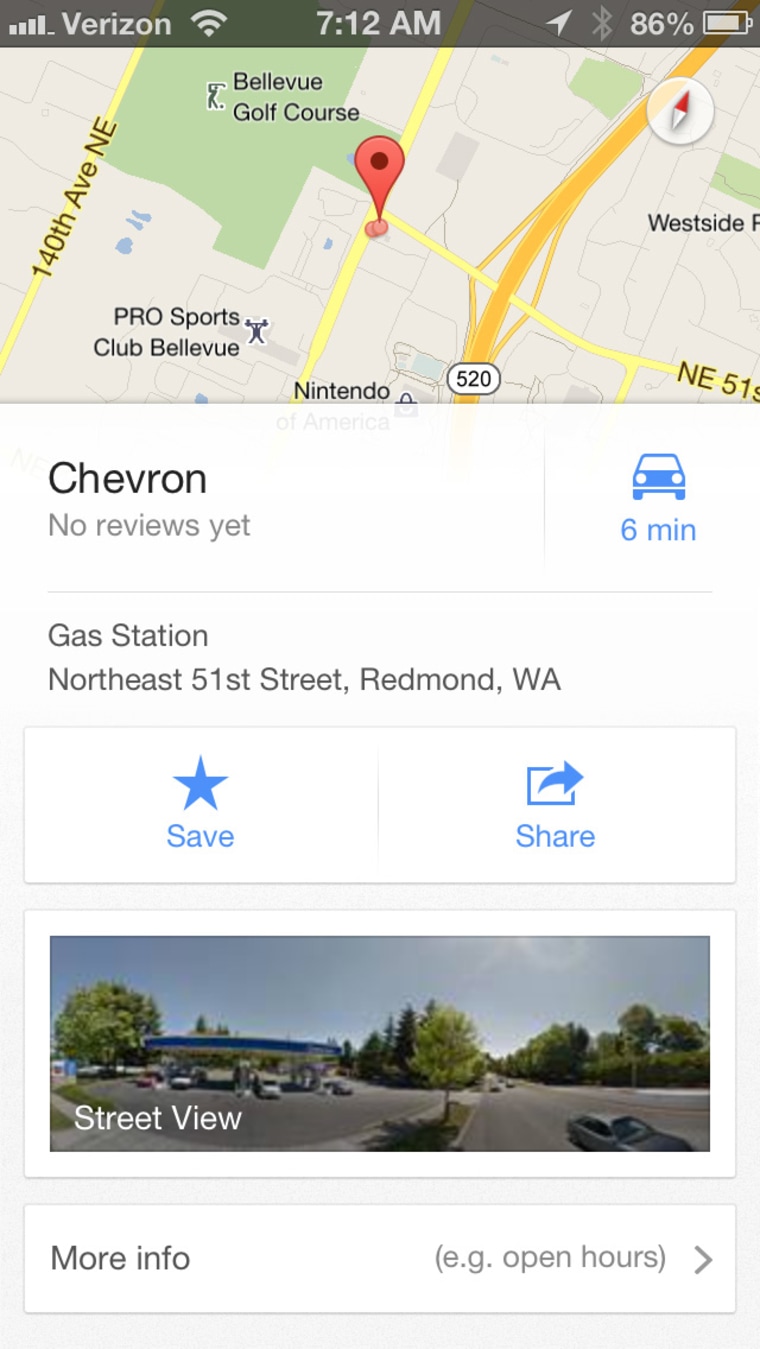As the brouhaha over Apple Maps failures reached fever pitch, rumors spiked about a new app in the works. Made by Google, it would run natively on the iPhone, bringing all of the previous features of the Google-powered Maps together with free navigation, the one thing it had been missing all these years. It seemed like a dream. Today, it is real.
It is what it sounds like, a return to those friendly yellow streets and orange highways, set in a soothing tan backdrop checked with green and blue bits of nature. But the app's interface is enhanced, and it syncs with your Google account so it can remember past searches, even if they were on other devices. And now it tells you where to turn as you drive, just like Apple Maps, and just like those $40 competitors in the App Store. Only it's free.
I don't want to overdramatize it, but it's hard not to. When the iPhone 5 came out, I decided to put my primary phone service on a Samsung Galaxy S III instead. After a few months of mounting annoyances, with only a few "oh, that's cool" moments to make up for them, I decided to switch back to the iPhone. My only misgiving: That I would lose the native Google Maps app. Yet the very same night that I switched my phone service to an iPhone 5 ... Lo! The Google Maps app did appear in the App Store.
It's not exactly the same as the one you get when you buy an Android phone. There are no swooping 3-D views, there seem to be fewer stalkery uses of Street View photography, and instead of a multitude of layers, there's just traffic, satellite view and public transit. But that's all that is needed — that and Google's own powerful local search engine — to be instantly superior to Apple's own troubled Maps.
The thing about Apple Maps isn't that it can't take you to an address you plug in — generally, it can. The problem is, the database of "points of interest" is so lousy, both in quantity and quality, that you end up yelling at the phone, "Yes, there is a Chuck E. Cheese on Johnson Street, don't tell me there isn't!!!" In a world where we are rapidly forgetting phone numbers and street addresses, the outcome is the same: You don't get to where you're going, and it's the Maps app's fault.
The other big Apple Maps problem, one that just seems like a profound oversight, is the lack of public transportation info. Google already earned the respect of straphangers with its comprehensive realtime public transit data, and you better believe that's all integrated into this new iOS app as well.
Yet Google is no dum-dum. Even though it has a monster head start over Apple in mapping, with 80 million POIs around the world and five million miles of road photographed by the Street View crew — not to mention "tens of thousands of updates" made to the database every day — it too has the occasional point-of-interest failure. It knows Apple's iPhone users are frothing at the mouth right now, and one false geotag could get it bit, too. So it displays this unprecedentedly comprehensive warning before you get to navigating:
Well, that's no vote of self-confidence! Some of that language may be required by law, but a lot of it sounds like covering one's rear end. Still, it's Google. Anything it does in mapping is inherently going to be better.
Look and feel
The Google Maps user experience is smooth and, for the most part, intuitive. Searching couldn't be easier, whether it's a particular restaurant or shop, a general POI search ("gas station") or an actual address. All of it goes into the same smart window, unlike some more cumbersome navigation apps out there.

Once you've decided on a destination, you navigate by tapping the little car icon. If you last took a trip by public transit, you will see a bus icon instead, but regardless, you can change your mode of transit on the next screen. Once you've picked your mode (and, in some cases, your route), you hit the Start button and you're off.
While driving, you see a much cleaner interface than Apple's. Over time, what ended up bothering me more than anything about Apple Maps was that even though it looked pretty, the screen was often crowded with words. Designers need to keep it spare, because I'm driving over here! I'm not going to read your novel. Google gets it right, with just the necessary information tucked neatly around an easy-to-read map.
Overall the look seems up to date, yet it sticks to the simplicity that everybody loved about Apple's old Google-powered Maps app. I am sure that as I use it I will find out things I dislike — and that I will also notice cool tricks I don't know about yet. But in this first look, I can already tell that we're in much better hands than we were with Apple Maps, and that's enough to breath a huge sigh of relief. (And for you people still on iOS 5 to upgrade to iOS 6, for Pete's sake!)
And oh yeah, it's even got a little Siri power. At least, you can enter searches with your voice rather than typing, and to fire up the app, you can tell Siri "launch Google Maps." She may not like it, but she complies.
Wilson Rothman is the Technology & Science editor at NBC News Digital. Catch up with him on Twitter at @wjrothman, and join our conversation on Facebook.